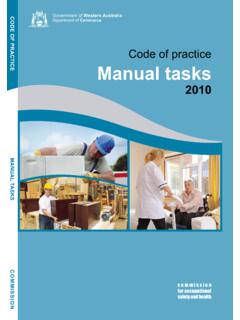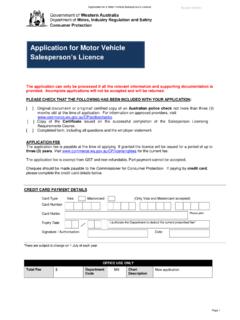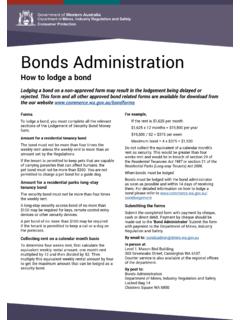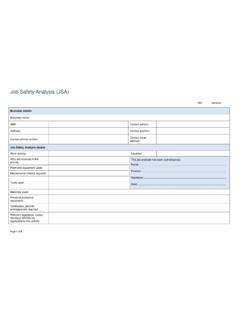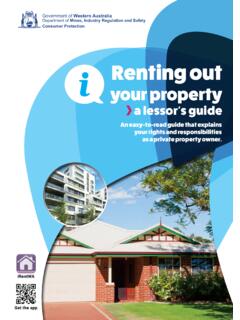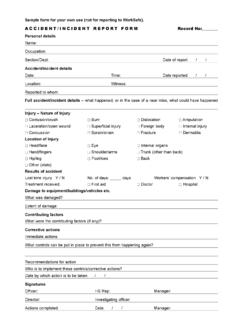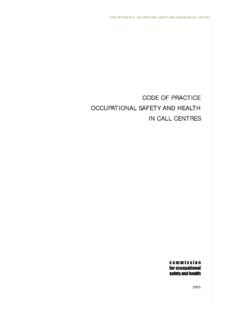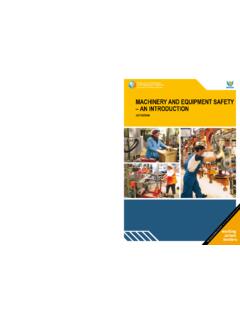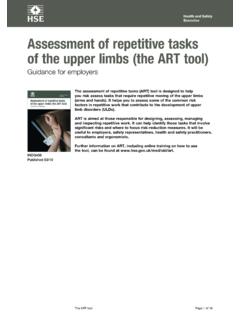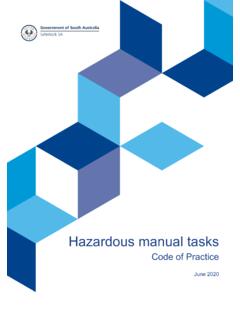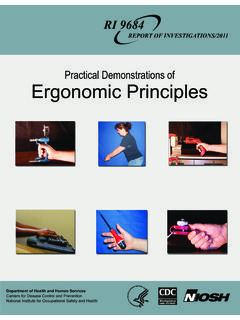Transcription of Preventing injuries from manual tasks in the workplace
1 1 Preventing injuries from manual tasks in the workplaceA risk management approach2 Purpose of this workshopAt the end of this workshop you should be able to: Identify, assess and control manual task risks in a systematic manner Understand the role of the employer and workers in this process3 Specific Learning Outcomes To understand what is meant by the term manual tasks and how they cause injury To understand the relevant legal requirements To apply the principles in the Code of Practice: manual tasks (2010) to identify, assess and control this approach?What is wrong with teaching people to lift safely?
2 5 OverviewIntroductionLegal SettingAnatomy/BiomechanicsManual Task Code & the Regulations Hazard IdentificationRisk AssessmentRisk ControlWho s Responsible?Conclusion6 manual tasksDefinition Any activity or sequence of activities that requires a person to use their physical body (musculoskeletal system) to perform work7 Hazardous manual TasksMany things that workers do involve performing activities that can be considered to be manual tasks . The term hazardous manual tasksis used to describe those that have the potential to cause injury 8 Examples of manual tasks9 Relevant Legal Requirements General Duty of Care Reporting & investigation requirements Risk management regulations Requirements to consult and co-operate Codes of Practice10 injuries from manual TasksThe types of injuries that can result from performing manual tasks include.
3 Sprains/ strains muscles, ligaments & tendons injuries or chronic pain affecting joints Disc injuries of the back or neck Injury to or compression of nerves Disorders affecting muscles or blood circulation Soft tissue injuries11 How injuries occurInjuries can occur from: Gradual wear and tear Sudden damage Direct trauma from unexpected events12 Cost of manual Task Injuries1 in every 3 lost time injuries is a result of performing manual in every 4 workers who suffers a manual task related lost time injury is off work for at least 3 & biomechanics Anatomy of the spine Body positions & postures Types of muscle work Principles of biomechanics The relationship between the human body and risk of injury14 Anatomy of the spine15 Trunk (spine) positionsflexion & extensionNeutral posture (standing straight)
4 = decreased risk of injuryAwkward postures (bending forwards/backwards) = increased risk of injury16 Trunk (spine) positionsside flexion & rotationNeutral posture (shoulders aligned over hips and toes) = decreased risk of injuryAwkward postures (bending sideways or twisting) = increased risk of injury17 Wrist positionsextension, neutral & flexionNeutral posture (hand in line with forearm) = decreased risk of injuryAwkward postures (hand bent forwards or backwards) = increased risk of injury18 Hand & forearm positionspronation & supinationNeutral posture (hand at mid-range: handshake position) = decreased risk of injuryAwkward postures (hand palm up or palm down) = increased risk of injury19 Types of muscle work DynamicMuscle contraction & movement.
5 StaticMuscle contraction & no muscle work (prolonged standing, sitting, holding hand/arm in one position) = increased risk of injuryREPETITIVE dynamic muscle work over time = increased risk of injury20 Principles of biomechanicsLoad close to body = decreased risk of injuryLoad further from body = increased risk of injury21 Using the spine as a craneLoad further from body = increased risk of injuryX22 Principles of Biomechanics: Back Obtain a wide base of support for stability Become familiar with the load and try to get a good grip of the load. Maintain neutral curves of spine Maintain load close to body Use the stronger larger muscles of the legs to create force where possible Execute smooth, controlled movement Stabilise the back by using abdominal muscles and deep back muscles where of Biomechanics.
6 Shoulders & Wrist Avoid work where the upper arm is away from the side of the body Avoid twisting Avoid holding one position for long periods of time Avoid repetitive movement Avoid long distance carrying Try to maintain the wrist and forearm in neutral postures24 Relationship between the human body and the risk of injuryThe risk of injury increases when: The body is using awkward postures, rather than preferred neutral postures Muscles are involved in static work (contraction without movement) or in highly repetitive movements The body is exposed to high/intense (one-off), cumulative (ongoing) or unexpected forces25 Where does this risk come from?
7 The sources of risk that create these body conditions where injury may occur include: Work area design and layout Nature of the item, equipment or tool The nature of the load The working environment Systems of work, work organisation and work practices26 Code of Practice: manual tasks Step 1. Hazard ID (spotting the problem) Step 2. Risk Assessment(understanding the problem) Step 3. Risk control (dealing with the problem)27 Code of Practice: manual TasksStep 1. Hazard Identification (spotting the problem)Regulations (a) and (2)(a) requires the employer, the main contractor or a self-employed person to identify each hazard that is likely to arise from manual tasks at the workplace , as far as is of Practice: manual TasksStep 2.
8 Risk Assessment (understanding the problem)Regulations (b) and (2)(b) requires the employer, the main contractor or a self-employed person to assess the risk of injury or harm (if any) to a person resulting from each hazard identified within manual tasks , as far as is of Practice: manual TasksStep 3. Risk control (dealing with the problem)Regulations (c) and (2)(c) requires the employer, the main contractor or a self-employed person to consider the means by which the risk (from hazards in manual tasks ) may be reduced, as far as is , Section 19 (1) of the Act requires employers, as far as is practicable, to provide and maintain a working environment in which employees are not exposed to identificationWhat is it?
9 The process of identifying factors within a manual task which could result in do we do it? To collect information and look for trends on risk factors within manual identification processStage 1 Look for where injuries / hazards are occurring 32 Hazard identification processStage 2 Talk to workers & OSH Reps about the tasks that cause problems33 Hazard identification processStage 3 Look at tasks being performed34 Hazard identification processStage 4 Collect information and look for trends3536 DISCUSSION POINT With the person next to you, list 5 manual tasks in your area that could cause an injury & whyManual tasks are more than lifting.
10 They can include static postures, repetitive movements, vibration, assessmentWhat is it? The process of determining which identified factors within a manual task have potential to cause injury, and do we do it? To determine appropriate ways of dealing with assessment processStage 1 Prioritise tasks for assessment39 Risk Assessment Matrix40 Risk assessment processStage a manual task Break the task down into activities involved 41 Risk assessment processStage the problemLook at the principle risk areas42 Holding loads or arms away from trunk Reaching upwards or handling loads above shoulder height Bending back or neck forwards and handling loads below mid-thigh height Twisting the back or neck Sideways bending or load handling on one side Long carrying
